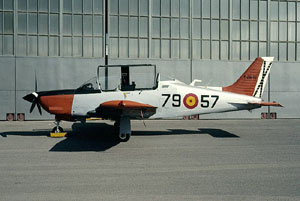
For any trainee fixed wing pilot, it all starts with this trainer, the Chilean developed ENAER T-35C Pillan. Known as Tamiz (gold sieve) in Spain, the type is based with Ala 79 at San Javier just outside of Murcia.
|
Spanish military aviation
|
|
Not one of NATO's founding members, Spain only joined the alliance in 1982. In 1975, the country had shed the
Franco dictatorship and became a Parliamentary democracy.
Spain and it's armed forces were a welcome addition to NATO. After all, the country guards the entrance
to the Mediterranean. Furthermore, NATO's southern flank was now an uninterrupted front from Portugal
to Turkey.
In the late 1960's the Spanish Air Force, known as Ejercito del Aire or Fuerza Area
Espanola, still flew descendants of the German
Heinkel He.111. Thirty years later, the EdA is about to introduce the Eurofighter Typhoon in service.
Today, Spain is in possession of a capable and varied fleet with the main combat type being the Boeing
F/A-18 Hornet. The Dassault Mirage F.1 plays a smaller role. Transport is provided by Lockheed C-130H Hercules
as well as indigenous types like the CASA. C.212 Aviocar and the CASA/IPTN CN.235 developed
in cooperation with Indonesia. Flight training is handled by the Chilean ENEAR T-35C Pillan and the Spanish
CASA C.101 Aviojet. Like in many other countries, Spain's Army has a largely helicopter equipped Aviation Service, the FAMET (Fuerzas Aermovilas del Ejercito de Tierra), meaning Air Mobility Force of the Army. The Navy has an Air Arm as well, known as Arma Aerea de la Armada (Fleet Air Arm). All pictures (c) Hans Rolink. |
 |
T-35C E.26-10/79-35 For any trainee fixed wing pilot, it all starts with this trainer, the Chilean developed ENAER T-35C Pillan. Known as Tamiz (gold sieve) in Spain, the type is based with Ala 79 at San Javier just outside of Murcia.
|
 |
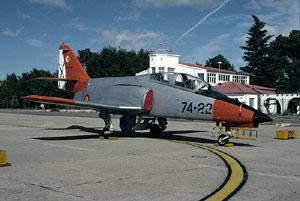
|
| A product of Spain's own
industry, the CASA C.101EB Aviojet is the EdA's primary jet trainer.
Nicknamed "Culo Pollo" (chicken butt), C.101's fly with the Air
Force Academy Ala 79 at San Javier and also with Grupo 74 at
Salamanca-Matacan in an instructor training role. To the left: E.25-11/79-11 of Ala 79 while one of Grupo 74's machines E.25-68/74-22 can be seen to the right
|
|
 |
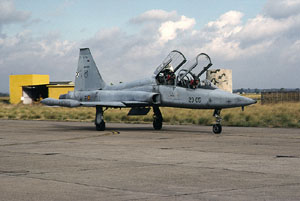 |
|
The Northrop F-5 is no longer in use as an operational fighter type. However, as
an advanced trainer, the type is still very useful. Ala 23 at Talavera la Real near
Badajoz flies the SF-5B two seater as a Lead-in Fighter Trainer.AE.9-017/23-10
displays the old silver
colour scheme, with AE.9-011/23-05 in the now standard two tone grey
scheme.
|
 |
 |
| The current mainstay of the
EdA is the F/A-18 Hornet. Known as EF-18A/B in Spain, 72 Hornets were
built new to replace F-4C Phantoms with 25 being received second-hand from
the US Navy to replace Mirage IIIE's. Apart from with Ala 12 at Torrejon,
Hornets fly with Ala 15 at Zaragoza and Ala 21 at Moron de la Frontera.
Furthermore, 461 Escadron at Gando, Gran Canaria also operates EF-18's. Single seater EF-18A C.15-61/12-19 and two-seater EF-18B CE.15-08/12-71 were both seen at Torrejon on 1 September 2001.
|

|
Mirage F.1M C.14-01/14-01 Until the arrival of the EF-18 Hornet, the Mirage F.1 was Spain's top fighter. Today, the Dassault Mirage F.1 remains active with Ala 14 at Albacete-Los Llanos. Ala 11 at Valencia-Manises only briefly operated the type before disbanding, while 461 Escadron at Gando, Gran Canaria converted to Hornets. Later in this decade, Ala 14 will convert to Eurofighter Typhoons. Until recently, the Mirage F.1 fleet had many sub variants. Original Spanish F.1CE and F.1EE single-seaters along with F.1BE two-seaters were joined by ex-Qatari F.1EDA single- and F.1DDA two seaters. Throw in some ex-French F.1C's and the logistical nightmare was complete. Through a modernization programme, all survivers , excluding the Qatari machines, have been brought to a common F.1M standard.
|
| RF-4C
CR.12-46/12-55 Spain is the last remaining country to operate the RF-4C version of the Phantom. 123 Escadron, part of Ala 12 at Torrejon, will propably retire the RF-4C during 2002. It's photo-reconnaissance task will then be taken over by pod-equipped EF-18 Hornets. |
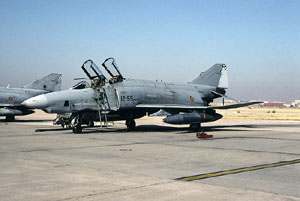 |
 |
C.212B
T.12B-33/72-04 The CASA C.212 Aviocar is the best known product of Spain's aircraft industry. This light transport is in very widespread service, not just in it's original role. This C.212A-1 transport version is part of 721 Escadron at Alcantarilla near Murcia. The unit is tasked with parachute training and is known as the "Escuela de Paracaidismo Mendez Parada". |
| C.212B
D.3B-06 Fitted with a thimble nose housing a search radar and a bulged rear window the T.12B becomes a D.3B and can be used for Search and Rescue missions. This so equipped aircraft D.3B-06 belongs to 803 Escadron at Quatro Vientos near Madrid. |
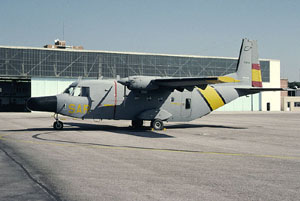 |
 |
Beech F.33C Bonanza E.24A-14/42-22 A large Air Force like the Spanish Ejercito del Aire often has specialized liaison aircraft at it's disposal. One of the types used is the Beech F.33C Bonanza, more usually seen as a private aeroplane. Operating unit is Grupo 42 at Madrid-Getafe. |
|
Beech Be.95-B55 Baron E.20-2/42-61 Even rarer in military service anywhere in the world is the Beech Baron. Originally a twin engined business aeroplane, the Baron is also used in the liaison role. |
 |
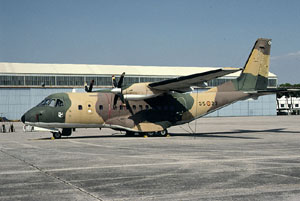
|
CN.235
T.19B-05/35-23 In cooperation with Indonesia's IPTN, CASA developed the CN.235, a very useful twin-engined light transport. In Spanish Air Force service, the type took over from the last remaining DHC.4 Caribous. The CN.235 serves with Ala 35 at Getafe near Madrid. |
| Falcon
50 T.16-1/45-20 Spain's large and varied VIP fleet, Grupo 45, among others consist of a single Dassault Falcon 50. Serialled T.16-1/45-20, this aircraft is part of Grupo 45 at Torrejon near Madrid. |
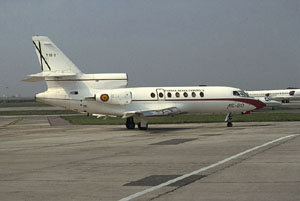 |
|
Cessna C.560 Citation TR.20-02/403-02 The other type flown by Escuadron 403 is the Cessna Citation. The type enjoys the advantages of a pressurized cabin and greater speed but is less capacious. Note the bulge in front of the wing which houses the cameras.
|
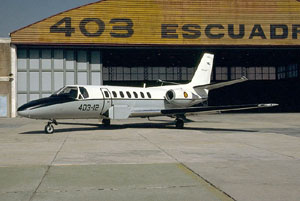 |
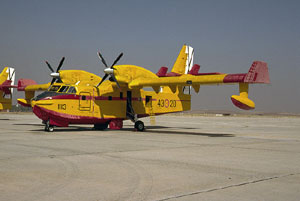
|
CL.215T
UD.13-20/43-20 One of the more unusual roles for any Air Force is fighting bush fires. For this purpose the EdA operates a fleet of Canadair CL.215T aircraft, converted from piston-engined CL.215's. The Canadairs operate with Grupo 43 at Torrejon, but deploy to various air bases during the summer season. |
| EC.120B
HE.25-8/78-28 Ala 78 at the air base of Armilla, just outside of Granada, takes care of helicopter training for the Spanish Air Force. The Eurocopter EC.120B Kolibri recently replaced the Hughes 269 in the primary training role. |
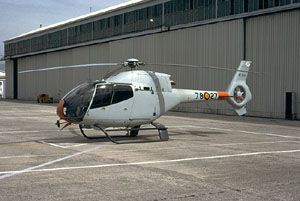 |
 |
S.76C
HE.24-1/78-01 Advanced helicopter training is done on the Sikorsky S.76C. Some years ago, the Sikorsky machine took over from the Bell UH-1H in this role. |
| SA.330J HD19-5 An important helicopter role in any Air Force is Search and Rescue. The Spanish Air Force maintains Puma detachments around the country for this purpose. An example is this SA.330J Puma HD.19-5 from 803 Escadron at Quatro Vientos. Although not as famous as Lloret de Mar or Salou, San Javier is a beach resort and the Air Base of San Javier is ideally placed to cover this area. |
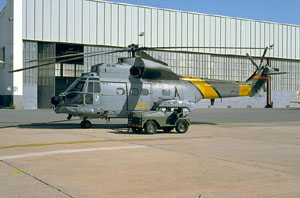
|
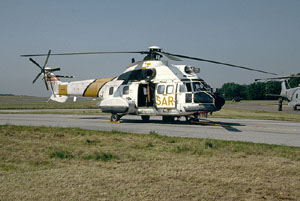 |
AS.332B
HD.21-12 Larger and more powerful than it's predecessor the Puma, the AS.332B Super Puma also serves the EdA in the SAR role. This particular machine is from Escadron 803 at Quatro Vientos, but was detached to Son San Juan at Mallorca at the time this photograph was made at Liege-Bierset in June 2001. |
| UH-1H HU.10-27/ET-207 Like in countless other countries, Spain's Army Aviation relies on the Bell UH-1H light transport helicopter. The FAMET would like more modern equipment, but so far budgetary realities have forced modernization of existing equipment. The UH-1H seen here belongs to BTRANS (Battallon de Transporte) at Colmenar Viejo near Madrid. |
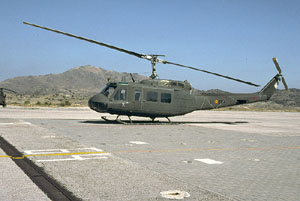
|
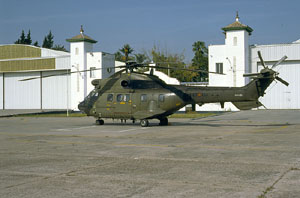 |
AS.332B
HT.21-16/ET-514 A more modern light transport helicopter in FAMET service is the AS.332B Super Puma. This particular example serves with BHELMA IV (Battallon de Helicopteros de Maniobra IV) at El Copero near Seville. |
| OH-58B
HR.12-7/ET-116 About to be retired from service is the Bell OH-58B Kiowa. The type's last user is the CEFAMET (Centro de Ensenanza de las Fuerzas Aeromovilas del Ejercito de Tierra, the Army's Aviation Training School . |
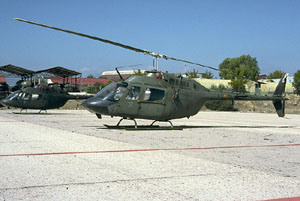 |
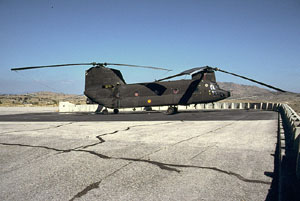 |
CH-47D
HT.17-07/ET-407 Heavy lift service is provided by the Boeing CH-47D Chinook. All serve with BHELTRA V (Battallon de Helicopteros de Transporte V) at Colmenar Viejo. |
| Bo.105GSH
HA.15-61/ET-162 The Spanish Army, like their German and Swedish counterparts, use the Bo.105 for anti-tank work. However, unique to the Spanish Army is the fire support version Bo.105GSH. This variant can be distinguished through it's hightened landing skids. The purpose of this modification is to provide clearance for a turret mounted cannon under the nose of the helicopter. This particular example is from BHELA I (Battallon de Helicopteros de Attaque I) at Almagro near Ciudad Real. |
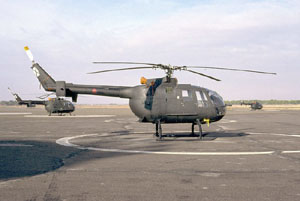 |
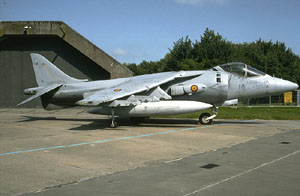 |
EAV-8B
VA.1A-21/01-909 Confusion surrounds the correct serialling of the Spanish Navy's second generation Harriers. The Spanish magazine Fuerza Aerea gives VA.1A as prefix for the EAV-8B. Anyway, VA.1A-21/01-909 of 009 Escadrilla visited Leeuwarden in the Netherlands for the annual Royal Netherlands Air Force Open Day on July 1 1994. The aircraft's home base is at Rota near Jerez. |
| C.550
U.20-1/01-405 Cessna C.550 Citation U.20-1/01-405 provides transport for the Armada. The unit that operates these aircraft is 004 Escadrilla at Rota, the home of Spanish naval aviation. |
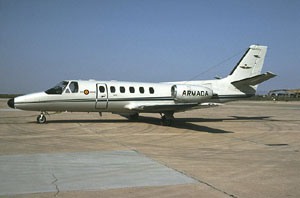 |